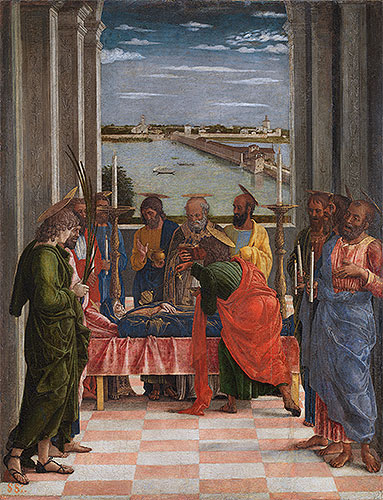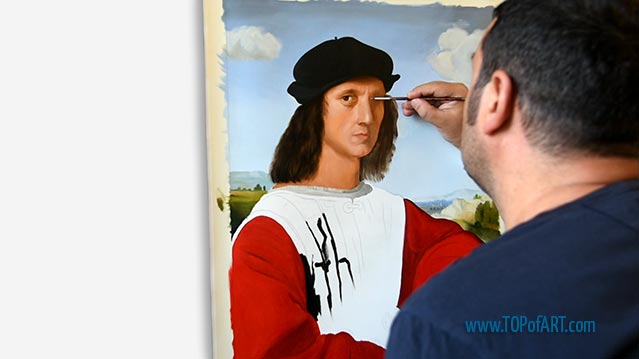Death of the Virgin, c.1462 Andrea Mantegna (c.1431-1506)
Location: Prado Museum Madrid SpainOriginal Size: 54.5 x 42 cm
Oil Painting Reproduction
If you want a different size than the offered
Description
Painted by European Аrtists with Academic Education
Museum Quality
+ 4 cm (1.6") Margins for Stretching
Creation Time: 8-9 Weeks
Creation Process
We create our paintings with museum quality and covering the highest academic standards. Once we get your order, it will be entirely hand-painted with oil on canvas. All the materials we use are the highest level, being totally artist graded painting materials and linen canvas.
We will add 1.6" (4 cm) additional blank canvas all over the painting for stretching.
High quality and detailing in every inch are time consuming. The reproduction of Andrea Mantegna also needs time to dry in order to be completely ready for shipping, as this is crucial to not be damaged during transportation.
Based on the size, level of detail and complexity we need 8-9 weeks to complete the process.
In case the delivery date needs to be extended in time, or we are overloaded with requests, there will be an email sent to you sharing the new timelines of production and delivery.
TOPofART wants to remind you to keep patient, in order to get you the highest quality, being our mission to fulfill your expectations.
We not stretch and frame our oil paintings due to several reasons:
Painting reproduction is a high quality expensive product, which we cannot risk to damage by sending it being stretched.
Also, there are postal restrictions, regarding the size of the shipment.
Additionally, due to the dimensions of the stretched canvas, the shipment price may exceed the price of the product itself.
You can stretch and frame your painting in your local frame-shop.
Delivery
Once the painting Death of the Virgin is ready and dry, it will be shipped to your delivery address. The canvas will be rolled-up in a secure postal tube.
We offer free shipping as well as paid express transportation services.
After adding your artwork to the shopping cart, you will be able to check the delivery price using the Estimate Shipping and Tax tool.
Museum Quality
The paintings we create are only of museum quality. Our academy graduated artists will never allow a compromise in the quality and detail of the ordered painting. TOPofART do not work, and will never allow ourselves to work with low quality studios from the Far East. We are based in Europe, and quality is our highest priority.
1 Reviews
5.00 Overall rating
The upper part of this work was mutilated before it reached the Prado. The missing section represented Christ - enclosed in a sort of wrapping of clouds spangled with cherubim against a background of a vault in the architectural style of Alberti - receiving the soul of the Virgin. A fragment has been found in the Vendeghini Collection in Ferrara. Therefore we can reconstruct the work, aided by the knowledge of a similar iconographic solution in the mosaic of the Mascoli Chapel in St. Mark's, Venice. Various suggestions have been proposed for the relationship between this picture and the mosaic, but critics now believe that the mosaic was a derivation from the Madrid panel, which from its style may be dated about 1460. There is no exact documentation on the work, but it is probable that it was part of the decoration of the chapel in the Castello di St. Giorgio, which Mantegna began for the Gonzaga family in about 1459 and which also included the beautiful panels now in the Uffizi. In the 19th century these were reunited to form a triptych, with the “Adoration of the Magi” in the centre, and the “Circumcision” and the “Ascension” at the sides. By 1460, Mantegna had completed his youthful Paduan experience and was preparing for his masterpiece in the Camera degli Sposi in Mantua. In our small panel the virtuosity of the epic narrator is transformed into an emotional tension that finds expression in the highly composed structure of the circle of Apostles around the bier (only broken by the figure leaning forward and swinging a thurible over the body of the Virgin), and in the chromatic force of every detail. It was the mellowness of colour and perhaps the crystalline luminosity of the landscape elements (a dam on the lake of Mantua?) that suggested Bellini as an author to Adolfo Venturi. This unsustainable hypothesis had a reasonable aspect. It is in the five years between 1456 and 1460 that Bellini was observing Mantegna most attentively, as is proven by his “Transfiguration” in the Museo Correr, which was considered to be by Mantegna.


